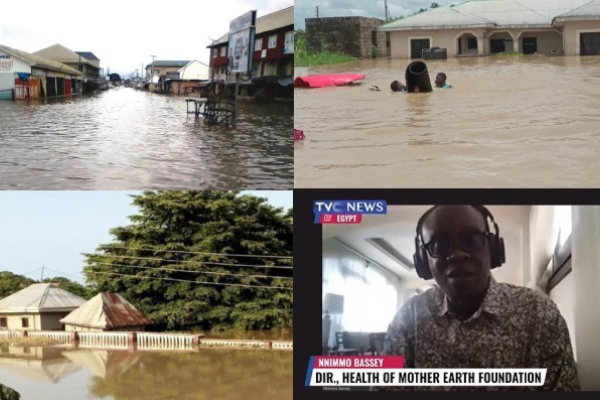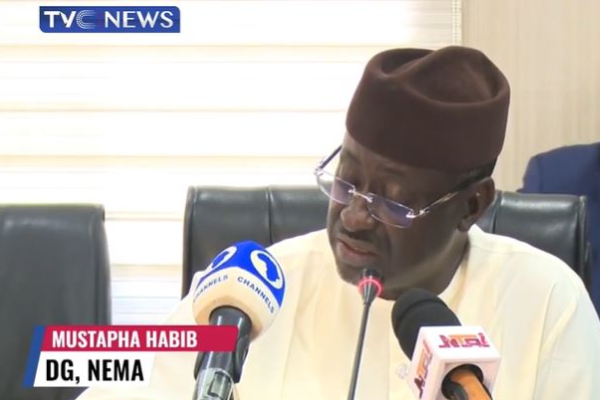Bayelsans are navigating one of the toughest times since the state was created on October 1996.
Communities in the riverine state located in the core of the Niger Delta have been submerged by floods.
The Bayelsa State Emergency Management Agency (BAEMA) say more than one million people have been displaced, while 96 people have been killed.
[wonderplugin_video iframe=”https://youtu.be/Fy41RXNmEbI” lightbox=0 lightboxsize=1 lightboxwidth=960 lightboxheight=540 autoopen=0 autoopendelay=0 autoclose=0 lightboxtitle=”” lightboxgroup=”” lightboxshownavigation=0 showimage=”” lightboxoptions=”” videowidth=600 videoheight=400 keepaspectratio=1 autoplay=0 loop=0 videocss=”position:relative;display:block;background-color:#000;overflow:hidden;max-width:100%;margin:0 auto;” playbutton=”https://www.tvcnews.tv/wp-content/plugins/wonderplugin-video-embed/engine/playvideo-64-64-0.png”]
The United Nations described the flood disaster as a crisis of major proportion, deserving global attention, but it seems the federal government does not share these sentiments.
Minister of Humanitarian Affairs, Sadiya Umar Farouq is currently getting tongue lashed for her statement that Bayelsa is not on the list of top ten states most devastated by floods.
According to statistics reeled up by the Minister, states like Jigawa, Anambra and Kogi are some of the worst hit.
Lawmakers, Elder statemen and youth from the Niger Delta are now calling on President Muhammed Buhari to immediately issue a sack letter to the Minister.
Environmental rights activist, Director, Health of Mother Earth Foundation, Nnimmo Bassey responding to claims by the minister, described the statement as very unfortunate for the minister or for anyone for that matter to make.
He said there are ways to use statistics to either help solve a problem or to compound the problem or cause a misunderstanding of situations.
Mr Bassey noted that Bayelsa state is the funnel by which the floods of the River Niger, Benue and others get into the Atlantic Ocean.
Secondly, the land is very low lying and thirdly, Bayelsa territory is also self subsiding.
“You have a territory that is sinking, a territory infected, impacted by sea level rise and then by this massive flooding emptying to the ocean through the area and somebody says not badly impacted.
“I think that was the most false declaration that anyone can make, no matter the level and statistics that is available to that person. It gets a sense of not understanding that this disaster is not a situation where we have to fight for medals, about who is most affected.
“We have to be compassionate even if one person lost his life in a region, it’s not to say we are not so much affected, we are going to move somewhere and look at somewhere else. It’s a very unfortunate situation.
“Bayelsa has been devastated. The East West Road that was a major contract awarded about 2006 is yet to be completed. And now large portions of that highway to Bayelsa state and other areas have been washed away.
Mr Bassey stated that the disaster is monumental, and it must be so appreciated.
Speaking further on the effect of flooding in Bayelsa, environmentalist and MD CEO, Mark Press, west Africa Limited, Idowu Salawu said Nigerians should not underestimate the effect and impact of the flooding that we’re having right now.
According to him, the effect from flooding when compared to war or insurgents, that of flooding is more.
“No one should play down on the issue of flood.
Mr Salawu stated that what we should be talking about is how to curtail the effect and impact of flooding in future.
Speaking on the statistics from the Bayelsa Management Agency, Mr Bassey noted that the information shows a very disastrous outlook for the state.
“States have been so devastated, farmlands, fisheries, infrastructure, people’s homes and it’s a situation where the whole stretch, the whole area that has been affected ought to have been declared environmental emergency zone because they were not very prepared for what was coming.
“We’ve also had warnings from the Metrological Agency, but warnings are not enough. They have to be structures that will help people cushion the impact of flooding when it happens, and this is happening every year, it’s going to be worse in the future, it may be worse next year or the year after.





